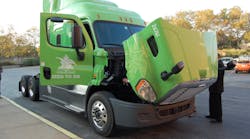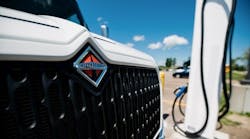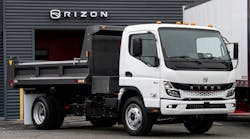ST. LOUIS. Converting trucks to run on natural gas is only part of a broader effort to create “greener” U.S. and global transportation and supply chain networks; “green” networks also must improve logistics efficiency and cut costs even as they produce less pollution.
That’s the argument put forth by a variety of shippers, logistics experts, equipment and fleet service suppliers here at the CNG Industry Leaders Forum put together by Gain Clean Fuel and hosted by Anheuser Busch at its Biergarten facility attached to its St. Louis, MO, brewery operation.
“We know every penny counts in logistics – our transportation spend is $1 billion a year – so you can’t just make changes purely from an environmental perspective,” stressed Billy Lawder, director of transportation engineering for Anheuser Busch.
“Part of our ‘seed to sip’ philosophy is ‘no miles, no emissions,’ but ‘no miles’ also means ‘no cost’ as well,” he said. “And every 100 lbs. we can save in weight – be it on vehicles or packaging – means a $1 million savings to us.”
Fabio Baldassari, logistics procurement group manager for North America at $67 billion consumer products giant Unilever, noted this his company’s 5-year plan is to double the size of its business while halving its “environmental impact,” reducing emissions, water usage, etc.
“We talk a lot about ‘conscious consumption’ at Unilever because to the next generation of consumer, it is no longer just about the dollar amount they pay for a product,” he explained. “It’s about the philosophy you believe in as a company and your plan to reduce your environmental impact. Otherwise, they will not buy your product.”
For example, Baldassri pointed to Unilever’s plan to cut its logistics-related carbon dioxide (CO2) emissions by 50% – an effort that includes the emissions generated by consumers driving to the supermarket to purchase Unilever goods. “We are trying to measure the total end-to-end, supplier-to-consumer transportation impact,” Baldassari noted.
Anheuser Busch’s Lawder noted that to make this “broader view” of emission-reduction efforts within the supply chain a success requires more “holistic” thinking about transportation needs.
“For example, since 2011 we’ve tripled our use of intermodal, as each railcar we use allows us to take four trucks off the road,” he said. “As a result we’ve added a rail hub back into our St. Louis operation.”On the truck side, Anheuser Busch is making large-scale and rapid investments in compressed natural gas (CNG) powered equipment.
In last 2014, it swapped out the 66 dedicated Class 8 tractors serving its Houston operation with CNG-fired units and did the same thing this year at its St. Louis brewery, swapping out 97 diesel-powered tractors for ones using CNG.
Yet Anheuser Busch is also dabbling in other transportation initiatives, too, for instance collaborating with 30 other companies to reduce total miles as well as empty miles accrued by both its in-house trucking operation and purchased transportation.
“We have an ‘open lane sharing’ policy to help fill the empty space on the trucks in our network; sometimes we can even reduce two lanes down to one by sharing transport this way,” Lawder noted. “We also ‘custom build’ payloads to the weight of the trucks in our network, to ensure we maximize every pound of capacity available to us.”
He noted that such efforts are doubly critical to Anheuser Busch as the beer market becomes more and more diverse due to rising demand for “craft brews,” which is, in Lawder’s words, creating “something of a logistics nightmare” in a way.
“We now have all these different products, many with different packaging, typically delivered in smaller loads,” he explained. “So we’ve really needed to change our logistics discussions as a whole on how to accommodate that.”
And Lawder stressed that corporate transportation managers themselves are being tied more and more closely to the success of their “green” efforts as well.
“I am asked at every performance review now if I am meeting my [green] targets – there’s constant pressure now from a global perspective,” he said. “In the past it was like paddling up a waterfall in a canoe. Now we’re driving a motorboat up a waterfall. The thing is we’re still going up a waterfall, in terms of reducing emissions without impacting performance or cost. That’s why this is not a short-term challenge.”




